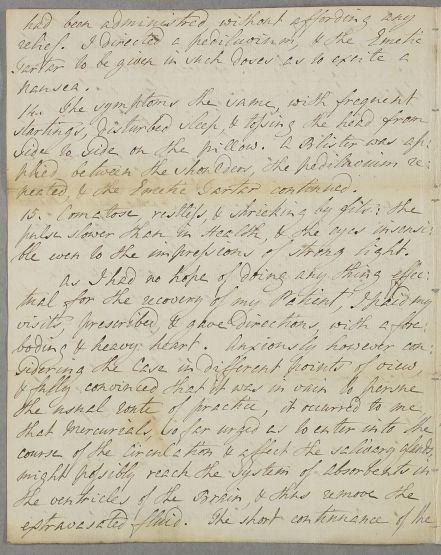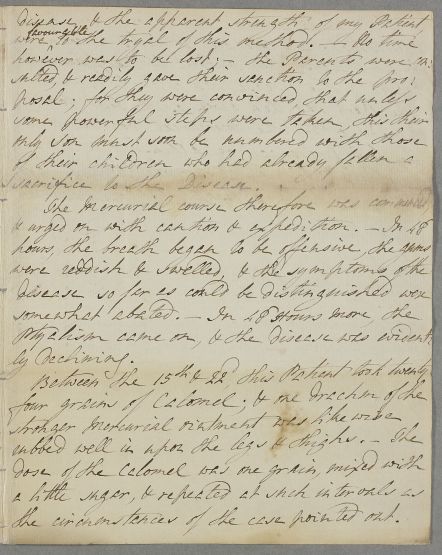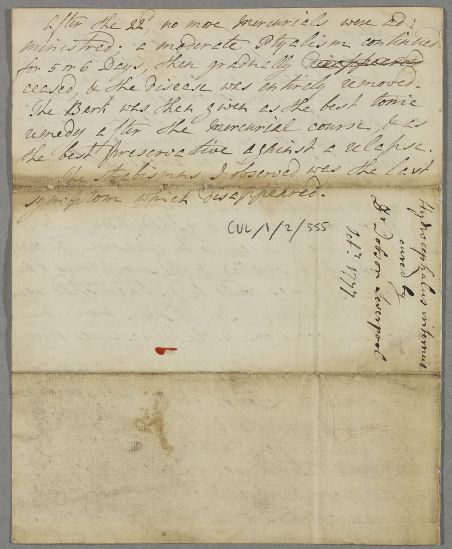
The Consultation Letters of Dr William Cullen (1710-1790) at the Royal College of Physicians of Edinburgh
[ID:1461] From: Dr Matthew Dobson / To: Dr William Cullen (Professor Cullen) / Regarding: C. (Patient) / October 1777 / (Incoming)
Letter from Matthew Dobson in Liverpool, regarding a case from February 1775. Mr C's young son was cured of 'hydrocephalus internus', which had previously killed other siblings. The boy was dosed with mercury to induce salivation and also rubbed with mercurial ointments.
- Facsimile
- Normalized Text
- Diplomatic Text
- Metadata
- Case
- People
- Places
Facsimile
There are 4 images for this document.

[Page 1]

[Page 2]

[Page 3]

[Page 4]
Metadata
| Field | Data |
|---|---|
| DOC ID | 1461 |
| RCPE Catalogue Number | CUL/1/2/555 |
| Main Language | English |
| Document Direction | Incoming |
| Date | October 1777 |
| Annotation | None |
| Type | Authorial original |
| Enclosure(s) | No enclosure(s) |
| Autopsy | No |
| Recipe | No |
| Regimen | No |
| Letter of Introduction | No |
| Case Note | No |
| Summary | Letter from Matthew Dobson in Liverpool, regarding a case from February 1775. Mr C's young son was cured of 'hydrocephalus internus', which had previously killed other siblings. The boy was dosed with mercury to induce salivation and also rubbed with mercurial ointments. |
| Manuscript Incomplete? | No |
| Evidence of Commercial Posting | No |
Case
Cases that this document belongs to:
| Case ID | Description | Num Docs |
|---|---|---|
| [Case ID:886] |
Case of Mr C's son, a child cured of hydrocephalus internus as reported by Dr Dobson of Liverpool. |
1 |
People linked to this document
| Person ID | Role in document | Person |
|---|---|---|
| [PERS ID:469] | Author | Dr Matthew Dobson |
| [PERS ID:1] | Addressee | Dr William Cullen (Professor Cullen) |
| [PERS ID:1613] | Patient | C. |
| [PERS ID:469] | Patient's Physician / Surgeon / Apothecary | Dr Matthew Dobson |
| [PERS ID:2520] | Patient's Relative / Spouse / Friend | Mr C. |
Places linked to this document
| Role in document | Specific Place | Settlements / Areas | Region | Country | Global Region | Confidence |
|---|---|---|---|---|---|---|
| Place of Writing | Liverpool | North-West | England | Europe | certain | |
| Destination of Letter | Edinburgh | Edinburgh and East | Scotland | Europe | inferred |
Normalized Text
On the 13th of February 1775, I was called
to the only son of Mr. C. – a Gentleman of this
Town. The child was between three & four years
of age; had been indisposed about eight days, &
had frequently complained of pain in His
head & of weariness & pain in his limbs; had been
sick by fits, & sometimes vomited; was fe¬
verish & could not bear the light.
On hearing this account, I was much alarmed,
as the Hydrocephalus internus had already
proved fatal to three children of this Family,
who had all been under my care; & that
this had been the Disease, was evident both
from the symptoms & the appearances on
Dissection. But my alarm was much en¬
creased on examining the little Patient.
The Pulse I found very frequent & irregular,
the head hot, the cheeks flushed, the pupils
dilated, & a great degree of strabismus. - There
remained no doubt as to the nature of the
Disease.
An Emetic, some Calomel powders & a purgative
[Page 2]
had been administred, without affording any
relief. I directed a pediluvium, & the Emetic
Tartar to be given in such doses as to excite a
nausea
14. The symptoms the same, with frequent
startings, disturbed sleep, & tossing the head from
side to side on the pillow. A Blister was ap¬
plied between the shoulder, the pediluvium re¬
peated, & the Emetic Tartar continued.
15. Comatose, restless, & shrieking by fits: the
pulse slower than in Health, & the eyes insensi¬
ble even to the impressions of strong light.
As I had no hope of doing any thing effec¬
tual for the recovery of my Patient, I paid my
visits, prescribed, & gave directions, with a fore¬
boding & heavy heart. Anxiously however con¬
sidering the case in different points of view,
& fully convinced that it was in vain to persue
the usual route of practice, it occurred to me
that mercurials, so far urged as to enter into the
course of the circulation & affect the salivary glands,
might possibly reach the system of absorbents in
the ventricles of the Brain, & thus remove the
extravasated fluid. The short continuance of the
[Page 3]
disease, & the apparent strength of my Patient,
were ↑favourable↑ to the tryal of this method. –– No time
however was to be lost; _ the Parents were con¬
sulted, & readily gave their sanction to the pro¬
posal; for they were convinced that unless
some powerful steps were taken, this their
only son must soon be numbered with those
of their children who had already fallen a
sacrifice to the Disease.
The Mercurial course therefore was commenced,
& urged on with caution & expedition. –– In 48
hours, the breath began to be offensive, the gums
were reddish & swelled, & the symptoms of the
disease so far as could be distinguished were
somewhat abated. –– In 48 Hourse more, the
Ptyalism came on, & the disease was evident¬
ly declining.
Between the 15th & 22d, this Patient took twenty
four grains of calomel; & one drachm of the
stronger mercurial ointment was likewise
rubbed well in upon the legs & thighs. – The
dose of the Calomel was one grain, mixed with
a little sugar, & repeated at such intervals as
the circumstances of the case pointed out.
[Page 4]
After the 22d, no more mercurials were ad¬
ministred; a moderate Ptyalism continued
for 5 or 6 Days, then gradually disappeared
ceased, & the disease was entirely removed.
The Bark was then given as the best tonic
remedy after the mercurial course, & as
the best preservative against a relapse.
The strabismus I observed was the last
symptom which disappeared.
hydrocephalus internus
cured by
Dr Dobson Leverpool
October 1777
Diplomatic Text
On the 13th of February 1775, I was called
to the only son of Mr. C. – a Gentleman of this
Town. The child was between three & four years
of age; had been indisposed about eight days, &
had frequently complained of pain in His
head & of weariness & pain in his limbs; had been
sick by fits, & sometimes vomited; was fe¬
verish & could not bear the light.
On hearing this account, I was much alarmed,
as the Hydrocephalus internus had already
proved fatal to three children of this Family,
who had all been under my care; & that
this had been the Disease, was evident both
from the symptoms & the appearances on
Dissection. But my alarm was much en¬
creased on examining the little Patient.
The Pulse I found very frequent & irregular,
the head hot, the cheeks flushed, the pupils
dilated, & a great degree of strabismus. - There
remained no doubt as to the nature of the
Disease.
An Emetic, some Calomel powders & a purgative
[Page 2]
had been administred, without affording any
relief. I directed a pediluvium, & the Emetic
Tartar to be given in such doses as to excite a
nausea
14. The symptoms the same, with frequent
startings, disturbed sleep, & tossing the head from
side to side on the pillow. A Blister was ap¬
plied between the shoulder, the pediluvium re¬
peated, & the Emetic Tartar continued.
15. Comatose, restless, & shrieking by fits: the
pulse slower than in Health, & the eyes insensi¬
ble even to the impressions of strong light.
As I had no hope of doing any thing effec¬
tual for the recovery of my Patient, I paid my
visits, prescribed, & gave directions, with a fore¬
boding & heavy heart. Anxiously however con¬
sidering the case in different points of view,
& fully convinced that it was in vain to persue
the usual route of practice, it occurred to me
that mercurials, so far urged as to enter into the
course of the circulation & affect the salivary glands,
might possibly reach the system of absorbents in
the ventricles of the Brain, & thus remove the
extravasated fluid. The short continuance of the
[Page 3]
disease, & the apparent strength of my Patient,
were ↑favourable↑ to the tryal of this method. –– No time
however was to be lost; _ the Parents were con¬
sulted, & readily gave their sanction to the pro¬
posal; for they were convinced that unless
some powerful steps were taken, this their
only son must soon be numbered with those
of their children who had already fallen a
sacrifice to the Disease.
The Mercurial course therefore was commenced,
& urged on with caution & expedition. –– In 48
hours, the breath began to be offensive, the gums
were reddish & swelled, & the symptoms of the
disease so far as could be distinguished were
somewhat abated. –– In 48 Hourse more, the
Ptyalism came on, & the disease was evident¬
ly declining.
Between the 15th & 22d, this Patient took twenty
four grains of calomel; & one drachm of the
stronger mercurial ointment was likewise
rubbed well in upon the legs & thighs. – The
dose of the Calomel was one grain, mixed with
a little sugar, & repeated at such intervals as
the circumstances of the case pointed out.
[Page 4]
After the 22d, no more mercurials were ad¬
ministred; a moderate Ptyalism continued
for 5 or 6 Days, then gradually disappeared
ceased, & the disease was entirely removed.
The Bark was then given as the best tonic
remedy after the mercurial course, & as
the best preservative against a relapse.
The strabismus I observed was the last
symptom which disappeared.
hydrocephalus internus
cured by
Dr Dobson Leverpool
Oct.r 1777
XML
XML file not yet available.
Feedback
Send us specfic feeback about this document [DOC ID:1461]
Please note that the Cullen Project team have now disbanded but your comments will be logged in our system and we will look at them one day...


